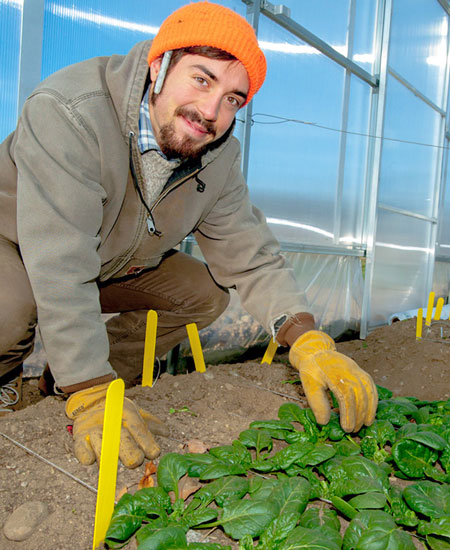
Becky Sideman, UNH Cooperative Extension vegetable and berry specialist, checks on research crops in a high tunnel at the N.H. Agriculture Experiment Station’s Woodman Farm
Now that the purple and blue shades of the polar vortex have eased off the weather maps, we can loosen our scarves and maybe go hatless. We’ve made it through the once-every-few-decades cold snap.
But last week, some were wondering if the spinach had made it.
UNH Cooperative Extension vegetable and berry specialist Becky Sideman and graduate student Connor Eaton have spinach growing in high tunnels up at Woodman Farm. They want to learn what varieties and planting schedules will work best to create a profitable crop for winter farmer’s markets.
When queried early last week about the spinach, Sideman admitted, “I’m also wondering whether the spinach was affected! Ours at home still looks good, so I expect it’s fine.”
Sideman noted that spinach can take a freeze and then unfreeze as the day warms up, and still be fine. “By growing spinach in an unheated high tunnel, a farmer saves on fuel costs and has a marketable crop in early spring,” she said. “The plants are extremely hardy.”
Spinach is a cut and come again crop, although eventually it will bolt and go to seed. Different varieties, of course, have different timetables, so which ones will best fill the bins at winter farmer’s markets is the question. These winter farmer’s markets have become increasingly popular, and there are now more than 30 in New Hampsire.

high tunnel at Woodman Farm.
Sideman’s research has attracted a wide variety of funders and collaborators (see list below). Even the new, moveable high tunnel at Woodman Farm, which is home to the N.H. Agricultural Experiment Station, was donated. But, as she states in one of her proposals for this project: “Since most of the successes using these methods have been shared anecdotally by farmers, there have not been replicated experiments evaluating the performance and suitability of various crops, varieties within a crop, planting date, and much more for these overwintering methods. Fundamental research is desperately needed for these systems.”
Last fall from the end of September to mid-November, Sideman planted several varieties of spinach along with some lettuces in the two unheated high tunnels at Woodman Farm. The high tunnels are greenhouse-like structures constructed with metal frames, which are then covered with plastic. One of the high tunnels can be slid forward or backward to accommodate different plantings during transitional seasons. The other high tunnel stays in place permanently.
In December when the weather turned colder, the spinach got more protection with the addition of row covers. These covers insulate the spinach by several degrees and the translucency of the material allows enough light for photosynthesis.
Last week, as we walked to the high tunnels, Sideman stopped to check on a student experiment with a low tunnel outside of the high tunnels. “Well,” she noted. “The cilantro is still alive, but that’s about it.”
Inside the high tunnel, the effect of the row coverings combined with the diffused light was kind of ghostly, but when Sideman lifted a cover and ducked in, there was the garden. The long neat rows of healthy spinach and lettuce looked good.
Sideman couldn’t help but do a little weeding, pulling out some chickweed. “Look it’s even flowering,” she noted. “The spinach would be fuller, but Connor has been harvesting the bigger leaves and tracking production. In February, the plants will really take off and then, if this was for production purposes, the crop would be ready in early spring for the winter farmer’s markets.”

Remarkably, the ground in the high tunnels doesn’t freeze much, just a bit around the edges. Watering is mainly done in the fall, and the dark rich soil created by UNH compost was clearly still moist enough. This experiment is not certified organic, but, Sideman explains, it is managed organically.
“What farmers are looking for in a spinach cultivar is a robust fast-growing plant with lots of easy to harvest leaves,” said Sideman. “The great thing about winter spinach is that, like winter carrots, it’s really sweet and wonderful to eat.”
It’s this kind of research and sense of possibility that’s attracting young farmers to the field. Connor Eaton, who’s earning his master’s degree in sustainable agriculture and food systems, came from Vermont to study with Sideman. “I got interested in this research because I have a strong interest in local agriculture and have been involved in the field for a while,” wrote Eaton. “This project interests me because it really moves our local food movement a step further. In better understanding how to use high tunnels, we can potentially provide high-quality fresh vegetables throughout the winter without using high-energy inputs.”
Funding Agencies, Partners, and Supporters
College of Life Sciences and Agriculture
Communities Involved in Sustaining Agriculture
New England Vegetable & Berry Growers Association
N.H. Agricultural Experiment Station
N.H. Department of Agriculture, Markets & Food
N.H. Vegetable & Berry Growers Association
Northeast Sustainable Agriculture Research and Education Program
Rimol Greenhouse Systems and Ledgewood Farm in Moultonborough, N.H.
Seacoast Eat Local
UNH Cooperative Extension
University of New Hampshire Engaged Scholars Program
Originally published by:
UNH Today
Photography of Becky Sideman and the high tunnel by Carrie Sherman. Photography of Connor Eaton by Lisa Nugent.
-
Written By:
Staff writer | Communications and Public Affairs
















































